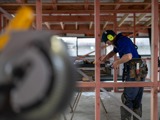How much of the premises will be considered affected will depend on the project. 'Affected by building work' can mean work occurring on the premises, or work being done elsewhere in the building if it poses a threat to public safety on the premises.
In many cases, the areas affected will vary at different times during the project. Whatever the case, access to the affected part of the premises needs to be restricted.
The safety precautions you should take would be similar to those undertaken under the Health and Safety at Work Act 2015 managed by WorkSafe.
For example, if you were adding an outside extension or smoking area to a public bar the business could remain open, but in a limited capacity while building work is under way. The public must be able to enter without passing by or through the building work. The site and any tools or materials must not be accessible to the public. The public must not be able to access any part of the premises where the structural integrity is compromised by the work, or where the public’s safety is jeopardised.
People who control premises are also responsible for ensuring members of the public can use their premises safely. If premises are affected by building work, this could include ensuring barriers are put up to restrict access, or in some cases it could involve closing premises.




